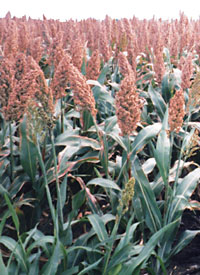Link b
Japanese
|
HOME@@Environmental Activities@@Our Approach to Sorghum Our Approach to SorghumEffectively using sorghum stalks, an agricultural waste, as a substitute for wood What is sorghum?Known as kaoliang in China and morokoshi in Japan, sorghum (or millet) is an annual grass of the Poaceae family that is cultivated widely as a cereal crop in the United States, India, China, and other wide regions of the world.Sorghum grain is currently used as a cereal for human food and animal feed, and the stalk remains mostly unused after the harvest. Koyo Sangyo developed sorghum board for use as a wood substitute by attaching those stalks together with our original adhesive KR Bond® then molding it into a board. With a hint from a collection of interviews with writer Ryotaro Shiba... In the summer of 1980, Koyo Sangyofs founder Tsugane Tanaka came across the comment that the gsorghum stalk is
as hard as bambooh in a collection of interviews with renowned Japanese author Ryotaro Shiba. With that hint,
the development of sorghum board began.
In the summer of 1980, Koyo Sangyofs founder Tsugane Tanaka came across the comment that the gsorghum stalk is
as hard as bambooh in a collection of interviews with renowned Japanese author Ryotaro Shiba. With that hint,
the development of sorghum board began.Sorghum board, which makes effective use of sorghum stalks that are not needed after the grain has been harvested, finally became a product after approximately 17 years development. Today, the company is continuing its work on developing new uses for the sorghum board and its practical application. In particular, because sorghumfs epidermis is covered in a wax layer, bonding it with normal adhesive is difficult. The adhesive technology of Koyo Sangyofs original adhesive KR Bond® (water-based polymer-isocyanate adhesive: JIS K6806) made it possible to solve this problem, and in 1996 we established a local corporation (Shenyang Xinyang Sorghum Plywood Co., Ltd.) in Shenyang City, Liaoning, China, and began production. Uses of sorghum board
Use as food dyeIn addition to using the sorghum stalk, the hull of the grain can be used to make natural food dye.The technology to extract natural food dye from the hull of the bright red sorghum grain had already been developed, and in 1996 Koyo Sangyo partnered with the Academy of Agricultural Sciences to establish Liaoning Keguang Natural Pigment Co., Ltd. in Shenyang City, Liaoning, China. The company conducts manufacturing and sales. |